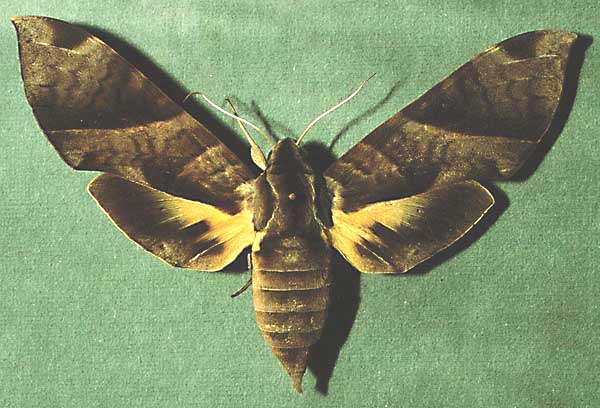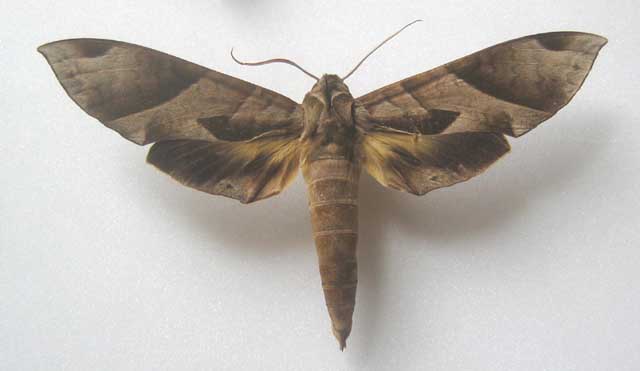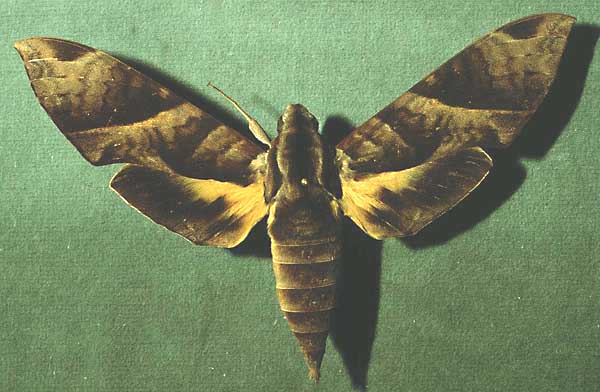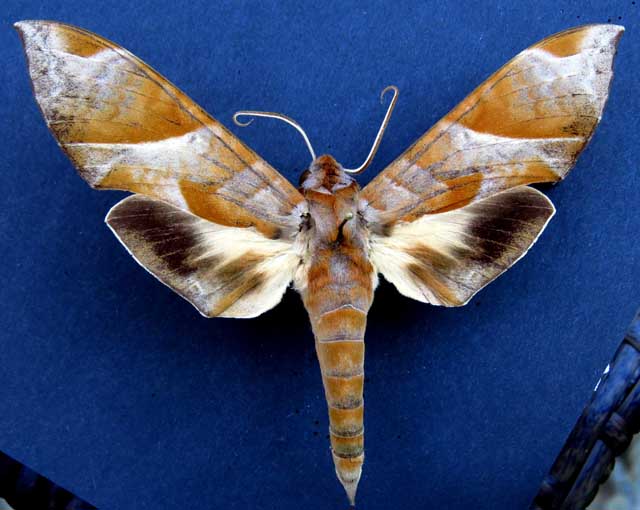Eumorpha obliquus obliquus
|
|
Updated as per
AN ANNOTATED CHECKLIST OF THE SPHINGIDAE OF BOLIVIA, October 2007
Updated as per http://biological-diversity.info/sphingidae.htm (Belize), November 2007
Updated as per Fauna Entomologica De Nicarauga, November 2007
Updated as per The Known Sphingidae of Costa Rica, November 2007
Updated as per personal communication with Jose Monzon (Guatemala); May 2009
Updated as per CATE (description; Mexico, Paraguay, Brazil, Ecuador, Peru); February 13, 2011
Updated as per personal communication with Jose Ramon Alvarez Corral (Barinas, Venezuela) May 28, 2012; ongoing
Updated as per personal communication with Bob Curry (Monagas, Venezuela), August 26, 2015
|
Eumorpha obliquus obliquus
you-MOR-fuhmah-BLEE-kue-uhs
(Rothschild & Jordan, 1903)
Pholus

Eumorpha obliquus obliquus female, Costa Rica, courtesy of Dan Janzen.
This site has been created by
Bill Oehlke at oehlkew@islandtelecom.com
Comments, suggestions and/or additional information are welcomed by Bill.
| TAXONOMY:
Superfamily: Sphingoidea, Dyar, 1902
Family: Sphingidae, Latreille, 1802
Subfamily: Macroglossinae, Harris, 1839
Tribe: Philampelini, Burmeister
Genus: Eumorpha, Hubner, [1807]
Species: obliquus obliquus, (Rothschild & Jordan, 1903) |
MIDI MUSIC
"What.A.Wonderful.World"
copyright C. Odenkirk
MIDI CITY
ON.OFF
<bgsound src="world.mid" LOOP=FOREVER>
|
DISTRIBUTION:
Eumorpha obliquus obliquus
(wingspan 130-136 mm) flies in
Bolivia: La Paz (700-1800m, November); and
probably throughout
most of Central and South America:
Venezuela: (Barinas (JRAC));
French Guiana: Kaw;
Ecuador;
Peru;
Paraguay;
Brazil, replaced in southeastern Brazil by Eumorpha obliquus orientis;
Mexico (Cate);
Belize: Cayo, Toledo;
Guatemala (JM);
Nicaragua: Jinotega, Granada, Rio San Juan;
Costa Rica: Guanacaste, Puntarenas, Alajuela,
Cartago, Limon, Heredia, San Jose.
I suspect it also flies in Panama, Colombia, Guyana and Suriname, but I have no confirmed reports as yet.
Most similar to Eumorpha anchemolus but forewing shorter, broader, with an even outer margin; forewing upperside a strong contrast between the generally light
basal half and the generally dark apical half; abdomen lacking a clearly defined dorsal stripe. Generally darker than Eumorpha obliquus guadelupensis and
Eumorpha obliquus orientis; underside of body yellowish, as in Eumorpha obliquus orientis (southeastern Brazil), rather than rosy as in Eumorpha obliquus guadelupensis (Guadelupe).
Labial palp segment 1 with white spot narrower and longer than in Eumorpha anchemolus. Conspicuous white line behind eye.
Underside of body and wings yellowish. Foretibia with outer surface grey.
Forewing upperside more glossy grey than in Eumorpha anchemolus; three oblique parallel lines present in basal area running straight from costal margin to
CuP fold; discal spot absent; oblique shadowy band broad extending to outer margin, where it is broader than in Eumorpha anchemolus; subapical costal patch
large; dark patch near tornus broader than in similar species of Eumorpha, rounded triangular, not concave distally, extending anterior to CuA2, but here not
narrowed; fringe of posterior margin buff, less extensive than Eumorpha anchemolus.
FLIGHT TIMES AND PREFERRED FOOD PLANTS:
Eumorpha obliquus obliquus adults are on the wing every month of the year in Costa Rica.
Eumorpha obliquus obliquus larvae feed upon grape species.

Eumorpha obliquus French Guiana, courtesy of
Stephane Vassel,
id by Jean-Marie Cadiou and Jean Haxaire.
ECLOSION, SCENTING AND MATING:
Pupae wiggle to surface just prior to eclosion. Females call at night, and males (below) fly into the wind to pick up and track the pheromone plume.

Eumorpha obliquus obliquus male courtesy of Dan Janzen.

Eumorpha obliquus, Cano Colorado, Monagas, Venezuela,
August 6, 1995, courtesy of Bob Curry, tentative id by Bill Oehlke.
EGGS, LARVAE AND PUPAE:
Larval Food Plants
Listed below are primary food plant(s) and alternate food plants. It is hoped that this
alphabetical listing followed by the common name of the foodplant will
prove useful. The list is not exhaustive. Experimenting with closely
related foodplants is worthwhile.
Return to Sphingidae Index
Return to Philampelini Tribe
Use your browser "Back" button to return to the previous page.
This page is brought to you by
Bill Oehlke and the
WLSS. Pages are on space rented from Bizland. If you would like
to become a "Patron of the Sphingidae Site", contact Bill.
Please send sightings/images to Bill. I will do my best to respond to
requests for identification help.
Enjoy one of nature's wonderments: Live
Saturniidae (Giant Silkmoth) cocoons.
 | 
Show appreciation for this site by clicking on flashing butterfly to the left.
The link will take you to a page with links to many insect sites. |





